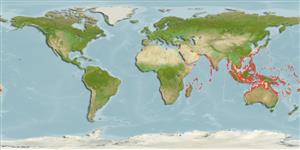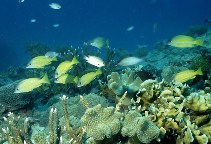Lutjanus quinquelineatus (Bloch, 1790)
Five-lined snapper
Adicionar as suas observações no Fish Watcher
| Native range | All suitable habitat | Point map | Year 2050 |

|
| This map was computer-generated and has not yet been reviewed. |
| Lutjanus quinquelineatus AquaMaps Data sources: GBIF OBIS |
Adicionar o seu Fotografias e vídeos
Pictures | Videos | Imagem do GoogleLutjanus quinquelineatus
Picture by Cook, D.C.
Pictures | Videos | Imagem do GoogleLutjanus quinquelineatus
Picture by Cook, D.C.
Classificação / Names Nomes comuns | Sinónimos | Catalog of Fishes(Género, Espécies) | ITIS | CoL | WoRMS | Cloffa
> Eupercaria/misc (Various families in series Eupercaria) > Lutjanidae (Snappers) > Lutjaninae
Etymology: Lutjanus: Malay, ikan lutjan, name of a fish.
More on author: Bloch.
Etymology: Lutjanus: Malay, ikan lutjan, name of a fish.
More on author: Bloch.
Environment: milieu / climate zone / depth range / distribution range Ecologia
marinhas associadas(os) a recifes; intervalo de profundidade 2 - 40 m (Ref. 9710). Tropical; 35°N - 37°S, 42°E - 176°W (Ref. 55)
Distribuição Países | Áreas FAO | Ecossistemas | Ocorrências | Point map | Introduções | Faunafri
Indo-West Pacific: Persian Gulf and the Gulf of Oman to Fiji, north to southern Japan. This species has been referred to as Lutjanus spilurus.
Tamanho / Peso / Idade
Maturity: Lm ? range ? - ? cm
Max length : 38.0 cm TL macho/indeterminado; (Ref. 55); common length : 30.0 cm TL macho/indeterminado; (Ref. 5450); Idade máx. registada: 31 anos (Ref. 34051)
Max length : 38.0 cm TL macho/indeterminado; (Ref. 55); common length : 30.0 cm TL macho/indeterminado; (Ref. 5450); Idade máx. registada: 31 anos (Ref. 34051)
Descrição breve Chaves de identificação | Morfologia | Morfometria
Espinhos dorsais (total) : 10; Raios dorsais moles (total) : 13 - 15; Espinhos anais: 3; Raios anais moles: 8. Dorsal profile of head steeply sloped. Preorbital width usually less than eye diameter. Preopercular notch and knob well developed. Scale rows on back rising obliquely above lateral line. Generally bright yellow, including fins, with a series of blue stripes on the side. A round black spot, about the size of the eye or larger, is below the anterior most soft dorsal rays, touching the lateral line but mostly above it (Ref. 469). Body depth 2.3-2.9 in SL (Ref. 90102).
Adults inhabit sheltered lagoons and exposed, outer slope coral reefs. Frequently encountered in large aggregations including 100 or more individuals at moderate depths, usually in 30-40m, like in some Pacific locations (Ref. 48635). Juveniles solitary and shallow in protected bays with algae and rubble substrates. They feed mainly on fishes and crustaceans (Ref. 4533).
Life cycle and mating behavior Maturidade | Reprodução | Desova | Ovos | Fecundidade | Larvas
Referência principal
Upload your references | Referências | Coordenador | Colaboradores
Allen, G.R., 1985. FAO Species Catalogue. Vol. 6. Snappers of the world. An annotated and illustrated catalogue of lutjanid species known to date. FAO Fish. Synop. 125(6):208 p. Rome: FAO. (Ref. 55)
Categoria na Lista Vermelha da IUCN (Ref. 130435: Version 2024-2)
Preocupação menor (LC) ; Date assessed: 05 March 2015
CITES
Not Evaluated
Ameaça para o homem
Harmless
Utilização humana
Pescarias: espécies comerciais; peixe desportivo: sim; Aquário: Espécies comerciais
FAO - pescarias: landings; Publication: search | FishSource | Sea Around Us
Mais informação
Population dynamics
Parâmetros de crescimento
Max. ages / sizes
Length-weight rel.
Length-length rel.
Frequência de comprimento
Mass conversion
Recrutamento
Abundância
Parâmetros de crescimento
Max. ages / sizes
Length-weight rel.
Length-length rel.
Frequência de comprimento
Mass conversion
Recrutamento
Abundância
Life cycle
Reprodução
Maturidade
Maturity/Gills rel.
Fecundidade
Desova
Spawning aggregations
Ovos
Desenvolvimento dos ovos
Larvas
Dinâmica larvar
Reprodução
Maturidade
Maturity/Gills rel.
Fecundidade
Desova
Spawning aggregations
Ovos
Desenvolvimento dos ovos
Larvas
Dinâmica larvar
Physiology
Body composition
Nutrients
Consumo de oxigénio
Tipo de natação
Velocidade de natação
Visual pigments
Fish sound
Diseases & Parasites
Toxicity (LC50s)
Body composition
Nutrients
Consumo de oxigénio
Tipo de natação
Velocidade de natação
Visual pigments
Fish sound
Diseases & Parasites
Toxicity (LC50s)
Genetics
Genética
Heterozygosity
Hereditariedade
Genética
Heterozygosity
Hereditariedade
Human related
Aquaculture systems
Perfis para aquacultura
Estirpes
Ciguatera cases
Stamps, coins, misc.
Aquaculture systems
Perfis para aquacultura
Estirpes
Ciguatera cases
Stamps, coins, misc.
Ferramentas
Bio-Quiz | E-book | Guia de campo | Chaves de identificação | Ferramenta auxiliar de frequências de comprimento | Ferramenta sobre a história de vida | Mapa dos pontos | Classification Tree
| Catch-MSY |
Relatórios especiais
Descarregue XML
Fontes da internet
AFORO (otoliths) | Aquatic Commons | BHL | Cloffa | BOLDSystems | Websites from users | Consultar FishWatcher | CISTI | Catalog of Fishes: Género, Espécies | DiscoverLife | ECOTOX | FAO - pescarias: landings; Publication: search | Faunafri | Fishipedia | Fishtrace | GenBank: genoma, nucleotídeo | GloBI | Google Books | Google Scholar | Google | IGFA World Record | MitoFish | Bases de dados nacionais | Otolith Atlas of Taiwan Fishes | PubMed | Reef Life Survey | Socotra Atlas | Árvore da vida | Wikipedia: ir para, procurar | World Records Freshwater Fishing | Registo zoológico
Estimates based on models
Preferred temperature (Ref. 123201): 24.7 - 29.1, mean 28.2 °C (based on 1068 cells).
Phylogenetic diversity index (Ref. 82804): PD50 = 0.5000 [Uniqueness, from 0.5 = low to 2.0 = high].
Bayesian length-weight: a=0.01349 (0.00886 - 0.02054), b=2.98 (2.86 - 3.10), in cm total length, based on LWR estimates for this species & Genus-body shape (Ref. 93245).
Nível Trófico (Ref. 69278): 3.7 ±0.2 se; based on diet studies.
Resiliência (Ref. 120179): Baixo, tempo mínimo de duplicação da população 4,5 - 14 anos (tmax=31; k=0.22-0.37; Fec>160,000).
Prior r = 0.33, 95% CL = 0.22 - 0.49, Based on 1 data-limited stock assessment.
Fishing Vulnerability (Ref. 59153): Low to moderate vulnerability (34 of 100).
Climate Vulnerability (Ref. 125649): High vulnerability (56 of 100).
Nutrients (Ref. 124155): Calcium = 39.6 [26.6, 57.1] mg/100g; Iron = 0.348 [0.224, 0.529] mg/100g; Protein = 18.4 [16.9, 19.7] %; Omega3 = 0.128 [0.090, 0.177] g/100g; Selenium = 52 [36, 76] μg/100g; VitaminA = 163 [30, 588] μg/100g; Zinc = 0.508 [0.408, 0.695] mg/100g (wet weight);




